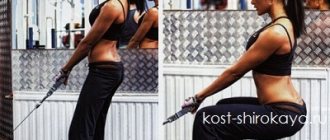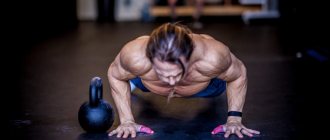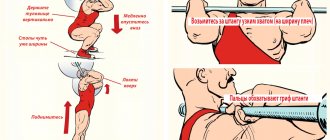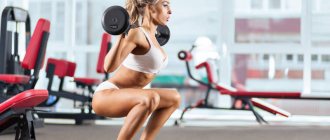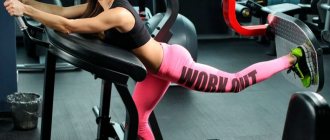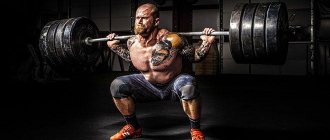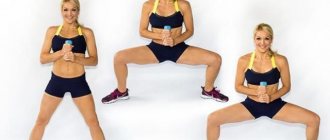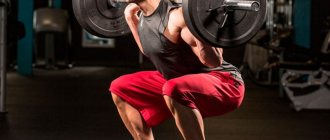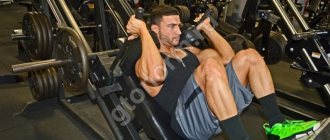There are basic exercises - very effective, and sometimes simply irreplaceable, which are rarely performed in gyms. One of them is goblet squats, they are also called goblet squats. Let's consider the technique of performing them, as well as who and when it is recommended to include such squats in the training program in order to achieve better results in building a strong and beautiful body.
Goblet squats got their name from the English “goblet” - cup. This association arose due to the fact that when performing them, the weight is held against the upper chest, like a heavy goblet from which one is about to drink.
Pros and cons of the exercise
Although squats with dumbbells between the legs are used mainly by girls, it has many positive qualities that will be equally useful for any person. These include:
- Intensive training of the leg muscles, especially the gluteal region and the inner thighs;
- Deep squats, especially when using stands, can improve blood circulation in the pelvic area. Due to this, blood microcirculation in the tissues of this area increases;
- Excellent stretches the tissues of the gluteal region, which allows you to work out the relief of this area well;
- Provides a slight isometric load on the core muscles.
The exercise cannot be called irreplaceable, but in terms of the effectiveness of working the target muscles, it is almost the best.
What it is?
The goblet squat with a kettlebell is a basic exercise for working the muscles of the legs and buttocks, which also engages the muscles of the core and arms. It consists of squats with a weight held at the level of the collarbones close to the body. The following can be used as a goblet (weight):
- weight (or two weights);
- dumbbell;
- barbell pancake;
- a plastic bottle with water or wet sand, or any other heavy weight at hand.
Goblet squats have many advantages, because they perfectly load most muscle groups of the body and do not require special sports equipment or a visit to the gym.
Execution technique
Before you begin the exercise technique, you need to choose the right weight. Most athletes prefer to work with dumbbells, as they are easier to hold in their hands. But classic goblet squats were performed with a kettlebell. With the correct grip, it can be comfortably placed in the palms, and due to its round shape, one of the edges will lie on the chest. Beginner athletes are recommended to take a weight of at least 8 kg. Since less weight will not give the required load.
Performance:
Approach the selected weight lying on the floor. We lean forward and grab the handle if it’s a kettlebell, or under the top plate when working with dumbbells.
It is important to perform the bend with a straight back. Throws the projectile onto his arms bent at the elbows. We press the weight (dumbbell) to the chest
It should seem to be pressing down with its own weight. We spread our legs slightly wider than shoulder width. The feet are turned in the direction where the knees are facing. Keep your back straight, your shoulder blades pulled together, your abs and buttocks tense. Make sure your body is stable. Adjust the projectile if necessary. As you inhale, slowly begin to move your pelvis back and bend your legs at the knee joint. We squat to maximum depth. Beginner athletes will find it difficult to immediately lower themselves into a full squat due to joint stiffness. Therefore, at first, sit down to a level that is comfortable for you. There is no need to pause at the bottom point; immediately, as you exhale, we come out of the squat by contracting the leg muscles. Only at the end do we connect the gluteus maximus to the movement.
Recommendations for implementation
- Keep your back straight while squatting. No need to lean forward. This will place more stress on the lumbar region. Your stability will also be compromised and you may fall forward under the weight of the weight.
- Elbows should point down, not to the side. If they are spread too far apart, they will rest against the thighs during a squat and will not allow us to descend as deeply as possible. When the elbows are directed downwards and brought together (as far as possible), they will freely pass into the space between the legs.
- Do not bring your knees together while squatting or coming out of it. This will place more stress on the knee joints. By performing goblet squats, you can help yourself avoid this mistake with the help of your elbows. If you notice that your knees are starting to move towards each other, simply spread your elbows to the sides and prevent them from doing this.
- There is no need to pause at the bottom point, since after it you simply will not be able to get out of the squat. To do this you will have to move your body forward, which again brings us back to the point about losing balance.
- Keep the weight close to your body. It was previously mentioned that the projectile should touch the chest. This will take the pressure off your shoulders and biceps, allowing you to perform the exercise with heavier weights. Plus, the weight will automatically tilt back a little and we will have to tense our abdominal muscles to counteract it.
- Do not twist your pelvis inward. This problem can arise due to low joint mobility. To avoid this, you need to move your pelvis back, not down.
- Do not perform inertial squats by kicking the knee joint. The exercise must be done under control. There is no need to drop down sharply and after the knee springs back into a stance
- Rounding in the upper back is not allowed. It should remain level. This mistake is more common among beginners, since the weight of the weight is sometimes taken too small. It is simply not enough to create a counterweight.
- When rising from a squat, the weight of the body should be on the heels. Shifting it onto your toes can injure your knee joints.
Training for beginner bodybuilders
If you immediately put a beginner under the barbell, there is a big risk that he will not understand the mechanics of the movement. The skill of keeping your back vertical and lifting through your hips, rather than by pulling your buttocks back, comes with experience. The front squat and goblet are more promising in this regard. They help the athlete get rid of mistakes, since it is simply not possible to stand up by lifting the buttocks while holding the weight in front of you.
The second important skill that you gain with the goblet squat is keeping your abs tense and breathing into the anterior abdominal wall. The third is movement by directing the knees towards the noses and bending them, and not by tilting the body forward.
Important: learning to squat with a barbell begins after the athlete learns to perform the movement technically correctly for 10-12 repetitions with a kettlebell or dumbbell. There is no need to delay this moment, as in the future the athlete may have problems with the motor stereotype.
Squats with kettlebells targeting the quadriceps
Kettlebell squats are a basic strength exercise, the main load of which falls on the quadriceps femoris muscle (quadriceps). Additional load falls on the calf and gluteal muscles. As you can see, squats with kettlebells are a compound exercise that involves several muscle groups at once.
Kettlebell front squats, also called front squats, are quite challenging. Correct execution of the exercise requires good concentration, physical training experience and proper technique. This version of squats with weights involves holding two weights on your shoulders in front of you as much as possible, without lowering the weights below your chest.
Benefits of Kettlebell Squats
Squats with kettlebells allow you to increase the strength and mass of the muscles of the thighs and buttocks.
In addition, the exercise has such advantages as developing the overall strength of the athlete and improving performance in other heavy basic exercises. Many muscle groups of the body are involved in the process of this movement.
By regularly performing squats with kettlebells, you can pump up your target muscles, increase your strength and endurance. Exercise will bring overall tone to the body.
Beginner athletes are advised to first master the correct technique. Take your time, work with your own body weight, feel the load and muscle contraction, and then gradually increase the weight of the apparatus.
What muscles are involved?
The exercise will be very effective for girls who want to have beautiful and toned hips and buttocks. The mechanics of the movement allow you to do squats very deeply, while the gluteal muscles will be actively involved. However, also keep in mind that the gluteal muscles, in turn, as a group of muscles are divided into three separate muscles: the gluteus maximus, the gluteus medius and the gluteus minimus.
In addition to the buttocks, squats with kettlebells engage the core stabilizing muscles, such as the abdominal muscles and lumbar back muscles. The calf muscles also work.
While holding weights on the chest or shoulders, the muscles of the arms (biceps, anterior deltoids) and forearms experience static load.
Technique for performing the squat exercise with kettlebells
The technique of performing squats with kettlebells requires knowledge of some features and nuances. Following strict technique allows you to get good results from this movement in a short time.
- Lift two weights onto your shoulders. Extending your knee and hip joints, place the weights on your shoulders. Rotate your wrists inward so the weights rest comfortably on your shoulders.
- Looking straight ahead throughout the exercise, squat down as low as you can and pause at the bottom of the range of motion. As you lower down, spread your knees out to the sides. You should squat, spreading your legs outward, keeping your torso upright, head and chest straight and slightly up.
- Rise back up, focusing on your heels, and repeat the movement.
- Repeat for the recommended number of reps.
Execution Features
Always stretch before performing squats. Also, in order to warm up the muscles, you can walk along the path in an intense manner for about 5-10 minutes; The back is straight throughout the entire approach, there is a slight deflection in the lower back; Watch the position of your knees, which should not go beyond your toes and move in the direction of your feet. Do not use inertia when going down and going up, do not swing your body, make the movement without using jerks; Keep your abdominal and lower back muscles tense. When the exercise is performed correctly, a certain load is also placed on these muscles. Exhale while going up, exhale while going down. Breathing is smooth and measured; Due to the mechanics of the exercise, squats with kettlebells can be classified as front squats, therefore the emphasis of the load falls on the quadriceps of the thighs
You should pay attention to this; we recommend including the squat exercise with kettlebells in your training program. Options:
Options:
It is possible to use two dumbbells instead of two weights when performing the exercise.
Video on squats with kettlebells
https://youtube.com/watch?v=kHKVaTa7C7M
This is interesting: Hack squats - we are considering the issue
Basic exercises
A kettlebell deadlift is essentially a squat. The exercise can be a simpler replacement for the barbell row because it does not require complex skills from the athlete. The athlete squats and grabs the kettlebell handle with both hands, and then stands up, straightening his legs. When squats, the projectile lowers and rises almost vertically, passing between the knees.
The one-arm kettlebell row is performed in much the same way as the deadlift. The weight is taken in one hand and raised, while the other hand is moved to the side. Each repetition can be accompanied by a change of hands, or you can first perform several repetitions for the left and then for the right.
The sumo kettlebell row is performed with one or two kettlebells. The main difference with the deadlift is the wide stance of the legs, the feet of which are turned to the sides. The exercise effectively engages the inner thigh.
Front squats with two kettlebells are done like this: the athlete sits up slightly and takes the kettlebells in each hand by the handles. Then he throws them so that each weight is comfortably placed between the pectoral muscle and the biceps of the arm in which it is located, and the handles are parallel to each other. After this, the athlete can align the handles to make it more comfortable and begin performing squats.
Front squats with one kettlebell are performed in much the same way. The kettlebell is placed next to the pectoral muscle and biceps, and the athlete supports it by the handle with the same hand. After this, squats are performed, during which the athlete must maintain a straight back position. The exercise is effective for developing balance.
Goblet or “goblet” squats are so called because the weight rests in the hands like a goblet. The grip can be different, and the kettlebell can be turned with the handle down or up, the main thing is that the projectile is placed under the chin at a short distance from the chest. This exercise is simpler than barbell squats, but it is very effective for developing the muscles of the buttocks and thighs, as well as mobilizing the joints, so it is often included in complexes for beginners.
“Gourmets” of kettlebell lifting also perform goblet squats, holding the kettlebell by the convex places, and not by the handle, which allows them to train their hands.
Overhead squats with two kettlebells are a very effective exercise for not only strengthening your muscles, but also mobilizing your shoulders and back. In order to perform it, the athlete takes weights in two hands, lifts them above his head and squats without lowering the weights.
The single kettlebell overhead squat is a more challenging exercise. To understand how to properly squat with a kettlebell in one hand, you need to try it: shifting the load will force you to distribute your body weight differently. In this case, you need to think about how the squat has approximately the same effect on both legs.
Goblet Squat Variations
There are various variations of this exercise, we will list them all:
- Classic goblet squats are performed with a kettlebell, and the weight must be adequate so that 25-30 squats can be performed at the limit of strength. If you can easily do this number of reps without even getting out of breath, you probably need to add weight.
- Some athletes prefer to perform squats with two kettlebells on their shoulders. This variety is considered more complicated in comparison with the classics; it allows you to additionally use the muscles of the back and shoulders.
- Some advanced athletes squat with a kettlebell, but hold it not by the handle, but by the convex body, placing a load on the hands.
- By analogy with the classic subtype, goblet squats with a dumbbell are practiced;
- The goblet squat with a kettlebell behind the back is considered an extremely labor-intensive variation, in which the load on the target muscles increases significantly;
- There is also a variant of such squats on one leg - suitable only for experienced athletes.
- Girls really like to do goblet lunges using the sumo technique - with a very wide stance of the legs, while the weight can be held both on the chest and in outstretched arms between the legs. What muscles work when squatting with a kettlebell between your legs? The muscles of the buttocks and the back of the thigh receive the lion's share of the load. That's why ladies are happy to shake their butts with this variation.
Goblet squats with dumbbell
If the athlete does not have a weight at his disposal, the exercise can be performed with a dumbbell. This option will be even more interesting, since the exercise is complicated by the lack of a comfortable grip. The principle of performing goblet squats is identical to squats with a kettlebell, but you will have to hold the dumbbell by weighted discs. If the dumbbell is collapsible, then the weight can be concentrated on one side of the sports equipment to destabilize the center of gravity. When performing goblet squats with a dumbbell, the static load on the arm muscles increases.
Benefits and Disadvantages of Kettlebell Squats
Goblet squats are relevant not only for CrossFit. It can be used to develop leg muscles in bodybuilding and in other sports that require strength training on the lower body. Even at home, without a barbell or dumbbells, it is quite possible to train your quadriceps and gluteal muscles with just one kettlebell.
But in CrossFit, goblet squats are relevant as an alternative to other squats. The fact is that CrossFit differs from bodybuilding and other strength sports in the variety of exercises and the frequency of their replacement. This was done so that the muscles do not get used to the load, to make the training process varied and more effective. But the benefits of this type of squats don’t end there.
- The peculiarity of goblet squats is that they provide a load as close as possible to everyday conditions, that is, thanks to the shifted center of gravity, the muscles must adapt to the new axis of the load to maintain balance. This means turning on more muscles and using more energy to perform it.
- Goblet squats provide a static load on the biceps, as well as the trapezius and latissimus muscles. This exercise is a basic one, since it involves most of the joints and muscle groups, which has a positive effect on the synthesis of testosterone, which triggers other processes in the body like a snowball - this includes fat loss, acceleration of metabolism and, of course, an increase in quality masses.
- Kettlebell squats are highly effective in developing strength endurance. This is achieved due to the specifics of the exercise.
- Another advantage of these squats is their large amplitude. Moreover, the muscles work in goblet squats at angles at which the muscles are not loaded in many other exercises. An indirect advantage of goblet squats is the development of speed and strength indicators, however, it is possible to develop these abilities only at a high speed of the exercise.
- The goblet squat is often included in training aimed at developing running speed. This exercise also improves blood circulation in general, including in the pelvic organs in particular.
Home workouts
The reasons why a person chooses home training are free and convenient. There is no need to go to the other end of the city and pay for the hall. Home workouts are only as effective as a person knows the technique of the exercises and can do them independently with sufficient self-discipline.
At home, you need to perform a large volume of training load, since this is the only way to get an active effect on the muscles. But training of this kind will only increase strength endurance, and not muscle volume.
Read also: Caramel color in clothes and beauty
Complex exercises
Russian kettlebell swings
Russian swings are a popular CrossFit exercise that came from kettlebell lifting, where it is an auxiliary exercise. It's similar to the standing front delt swing, but the movement itself is driven more by the hips and back rather than the shoulders and arms.
studioloco - stock.adobe.com
There are several options for performing Russian swings, and they can also be done with two kettlebells. The exercise develops well the muscles of the shoulder girdle, legs, lower back, and explosive strength of the lower body. A good option for beginners who will then have to learn the technique of more complex movements - pushes, pushes, pulls, etc.
Turkish get up with kettlebell
The Turkish get up is an example of a functional and efficient movement. The Turkish get-up works every muscle in your body. This exercise also works on shoulder mobility: you'll be sure to stabilize your shoulder by rotating it as you perform the task.
Pay attention to an important nuance that ensures the cleanliness of the Turkish get-up: when you stand up, the body must be fully straightened, and at the end and at the beginning of the exercise the projectile must touch the ground
Mihai Blanaru - stock.adobe.com
Kettlebell push
An exercise similar to the standing press, but with assistance from the legs. Also used in kettlebell lifting and crossfit. Since the clean and jerk is easier than the press due to a different technique, the weight here must be greater, which leads to an increased risk of injury. Be careful when increasing the working weight.
Short cycle push technique:
- Throw the weight over your shoulder with a jerk from the floor.
- Perform a push - squat down a little and immediately straighten up, while sharply throwing the weight up.
- Hold in the top position for a second, then return the projectile to your shoulder, lightly cushioning it with your knees.
The exercise can also be performed with two kettlebells.
Kettlebell Snatch
This exercise also comes from kettlebell lifting. The shoulders, trapezius, and spinal extensors work actively here; the legs are also involved, but less than when performing, for example, a kettlebell jerk into a squat position.
The technique is as follows:
- Place the weight in front of you, feet shoulder-width apart.
- Lean towards the apparatus, while bending your legs slightly. Do not round your back, keep a bend in your lower back throughout the entire exercise.
- Take the weight, make a small swing back and immediately begin lifting it up, helping with your body and pelvis. The arm should not bend or unbend - all movement is due to the inertia and efforts of the deltoid and trapezius.
- At the top point, fixate for a second and begin lowering. There is no need to put it on the floor - swing back and rise again.
Mihai Blanaru - stock.adobe.com
Emissions (thrusters)
Kettlebell throws are a goblet squat, squeezing the weight over your head at the same time as lifting.
The projectile in the starting position must be held with both hands on the sides of the handle at chest level. Feet are shoulder-width apart, toes slightly pointed to the sides. Then the usual bending of the legs occurs during squats until the thighs are parallel to the floor (or slightly lower) and further lifting, while simultaneously straightening the arms along with the weight. Do not forget that you need to keep your back straight, do not hunch or bend over.
Squat Pulldown
A combination of goblet squats and kettlebell rows to the chin. This exercise allows you to work your quadriceps, deltoids and trapezius.
Technique:
- Stand with your feet shoulder-width apart and grab the kettlebell by the handle with both hands.
- Keeping your back straight, do a normal squat.
- As you exhale, begin to stand up powerfully, while the weight, by inertia, will continue to go up after straightening your legs. Using the force of the deltoids and trapezius, continue its movement to the upper chest. The elbows should go up, above the level of the hands.
- Lower your arms and start a new repetition.
ifitos2013 – stock.adobe.com
Farmer's Walk
This exercise develops all the leg muscles, strengthens the grip, and the abdominal and forearm muscles work well here. The technique is simple - pick up two heavy weights and slowly walk forward in short steps. At the same time, do not round your shoulders, keep your back straight, and squeeze your shoulder blades together.
If you have absolutely no space, you can simply develop your grip and forearm muscles by simply holding the implements in place. A more advanced level is to increase the thickness of the handle, for example, by wrapping a towel around it.
kltobias - stock.adobe.com
Much more could be said about each of the exercises described, and by no means should the above be taken as a complete guide. Consider this information as the start of a new approach to your training.
» alt=»»>
https://youtube.com/watch?v=kHKVaTa7C7M
Additional recommendations
To get the maximum effect from this exercise and avoid injury, listen to the following recommendations:
- Before starting classes, be sure to warm up your joints and muscles by warming up, and do stretching exercises for the muscles of your legs and back.
- When lifting a heavy weight to the starting position, keep your back straight, arching at the lower back, this will protect you from injury.
- When performing the exercise, the torso should be tense, the shoulder blades should be brought together, the neck should not bend back, and the chin should be pointed down.
- To avoid losing your balance and falling backwards, goblet squats with a heavy weight should be done close to a wall, with your back turned to it. This will serve as a safety net in case you fall back.
- Carefully monitor the correct technique - maintain a natural lumbar deflection, do not start lifting up from the pelvis, do not bring your knees together.
Goblet squats are an effective basic exercise that perfectly works many muscle groups. It deserves to be included in the training programs of women, novice bodybuilders, as well as those who experience problems with the spine.
Bulgarian squats
Working muscles
As mentioned above, the work is performed by the same muscle groups that are involved in the classic squat. This includes the muscles of the back (biceps) and front (quadriceps) parts of the thigh, as well as the gluteus maximus muscles.
The abdominal muscles and core stabilizer muscles receive static load. In addition, if you perform Bulgarian squats with dumbbells, the muscles of the forearms, which have to hold the weight, are also in constant tension.
To whom, when and why
Most likely, most inexperienced athletes have never seen, and in general, simply do not know about this option for working out the leg muscles. In principle, this is not surprising - the exercise is quite rare and original, which is why it is not used everywhere. Bodybuilding is not just about squats and bench presses; there are many more interesting exercises.
To whom?
Despite the fact that the squat is a basic exercise, it is not recommended for beginners to include it in the complex. Weak muscles (especially the core stabilizing muscles) simply cannot cope with such a complex load.
The Bulgarian squat is usually performed by professional athletes who want to add variety to the program and stimulate muscle growth in a new way.
When?
Typically, this exercise is performed immediately after regular squats with a barbell in order to “finish off” the strained leg muscles.
In principle, it is equally suitable for both weight gain and “cutting”, since the muscles are worked out quite efficiently and deeply when doing it. However, you won’t be able to lift a lot of weight in this exercise (otherwise you simply won’t be able to maintain your balance), and therefore it is more often used when working on relief.
For what?
Most often, the main goal is to add variety to the complex, or “refinement” of the muscles after squats. Sometimes it is included in the “drying” program, but usually this is also done in combination with the classic squat.
Technique for performing Bulgarian squats
As weight, you can use either a barbell or two dumbbells (or just weights from a barbell, if they have convenient slots). The second option is less dangerous - maintaining balance with dumbbells is much easier and easier than with a barbell on your shoulders - so we will consider this method.
- We take dumbbells in our hands, lower them freely along the body and stand in front of the bench. We take one leg back and rest our toes on the surface of the bench. The second one is placed a little in front (15-25 centimeters) from the body.
- We gradually begin to squat until the thigh of the leg in front is approximately parallel to the surface, and the knee joint of the second leg almost touches the floor. The body must remain straight and maintain an upright position throughout the entire movement.
- After a short delay, we smoothly straighten the knee of the leg in front of us and straighten.
- Perform the required number of repetitions for each leg.
Important nuances and tips
Working weight. In this exercise, using maximum weights is extremely dangerous - it is very easy to lose balance, even with dumbbells (not to mention a barbell). Therefore, an average or minimum working weight is used. Number of repetitions. Optimal – from 8 to 15. Execution speed
Since it is very easy to lose your balance if you move quickly and carelessly, you should squat and rise smoothly and slowly. Frame. Keeping the straight body in a vertical (relative to the floor) position is an important aspect that affects the effectiveness of the exercise.
Keeping the straight body in a vertical (relative to the floor) position is an important aspect that affects the effectiveness of the exercise.
Leaning your torso forward will reduce the load on the “working” quadriceps.
- Hind leg. You can understand how far you need to stand from the bench as follows: the knee at the bottom point of the movement (squat) should almost touch the floor. Based on this, choose the distance to the bench yourself.
- Front leg. Be sure to place the leg that will perform the squat forward - otherwise you simply will not be able to do the movement correctly. If 15-25 centimeters (as mentioned above) is not enough for you, place your foot even further.
- Delay at the bottom. The question of whether it is necessary to linger at the bottom point is quite controversial, and each athlete in this regard must decide for himself whether to do it or not.
- Foot. The toe is placed straight, turning it to the sides is not only dangerous, but also ineffective. It is imperative to ensure that the heel at the bottom point of the movement does not come off the floor - otherwise it is necessary to place the foot even further.
Now you know how to pump up your legs with Bulgarian squats.
The benefits and harms of goblet lunges
So, we have looked at the technique of performing goblet squats, and then we will find out why they are so useful:
- Contribute to the formation of a beautiful figure in the buttocks and hips;
- Allows you to effectively load the abdominal muscles;
- Gives muscle tone and allows you to develop a sense of endurance;
- They help establish the correct technique for classic squats;
- Helps improve posture;
- With the correct technique, joint mobility is developed;
- Athletes who do not have the opportunity to go to the gym will be pleased with the versatility of the exercise, because it can be performed at home using a handy weight - a jar with sand, a dumbbell, etc.
Can goblet squats cause harm?
- They will not help you pump up a lot of volume, so athletes who work hard to do them will only get tired in vain. Yes, they will become more resilient and tone their muscles, but in order for them to grow, they need to work with heavier weights.
- If the technique of performing squats with a kettlebell is not followed, there is a risk of injury to the knees, back, and ankle joints;
- Also, the exercise can harm the body if you practice it in the presence of contraindications:
- Injuries and diseases of the ligaments and joints of the legs and arms;
- Diseases of the musculoskeletal system;
- Severe pathologies of the cardiovascular system;
- Pregnancy;
- After a heart attack and stroke;
- Glaucoma;
- After abdominal operations;
- Feeling unwell, headache;
- Inflammation, colds, elevated body temperature;
- Exacerbation of chronic diseases;
- Etc. (we hope for your prudence).
Well, now you know how to do goblet squats with a kettlebell, we hope they will take a strong place in your training program. If for some reason you cannot practice them, try replacing them with front squats with a barbell, hack squats, Smith machine squats, deadlifts, machine leg raises, and leg presses. When choosing an alternative, consider how you feel and the reason why you cannot do goblet squats.
Execution technique
You need to start training by choosing “your” kettlebell. Its weight should be such that you can not only hold the projectile, but also complete the assigned tasks. If you train according to a program compiled by an instructor, then the weight is already indicated in it. For effective training, perform exercises every time you visit the gym.
Learn the benefits of squats for men and women, as well as how to do Bulgarian and deep squats correctly.
The optimal number of visits is 3–4 10–15 times:
Take your starting position. Feet shoulder-width apart, toes pointing slightly outward. Capture is performed in two ways. The first is to place the weight in front of you and lift it with a jerk. The second is to take the weight in your hands at chest level along with the starting position and bring it as close to your body as possible. Inhale deeply, and as you exhale, squat down with a straight back. The depth of the squat depends on individual abilities - the level of flexibility and physical fitness. Professionals squat as low as possible. Beginners - to parallel levels
Pay attention to the sensations in your knees. Lower your elbows down
If you do deep squats, your elbows bend under your knees. As you inhale, rise up. Make sure that all the tension is directed towards your heels and your knees point outwards. Squats for girls are effective in combination. Squat with dumbbells against the wall with a leg lunge. Without resting, begin the goblet squat with your feet shoulder-width apart.
Video: technique for performing the squat exercise with a kettlebell
If you are training at home and don’t have a kettlebell at hand, girls are advised to use a water bottle instead. Regular visitors to the gym practice training with two weights. But this practice is only for experienced ones.
Did you know? In the past, every circus performance included a number with strongmen who famously threw weights.
Is squatting with a kettlebell good for girls?
Many girls, when they come to the gym, at first are content with squats. However, over time this becomes not enough. And you need to include more exercises in your training program:
- Squats with a kettlebell for girls are one of the most optimal options, which allows you to shift the load and pump up your legs efficiently.
- Squats with a kettlebell are no less useful for men, thanks to which you can dilute the training program.
- The exercise itself “shocks” the legs well, due to the shift in weight and body position.
- Recommended for those who experience stagnation in training and progress.
Legs
Goblet Squats
The first type of squats focuses on the quadriceps. Also, a good load goes to the gluteal muscles. The hamstrings, calves, spinal erectors and abs work as stabilizers.
The technique is:
- Take the kettlebell by the handle on your sides with both hands, stand straight, feet slightly wider than shoulder-width apart, toes pointing slightly to the sides.
- Without changing the angle of your back or hunching, squat so that your thighs form an acute angle with your shins, that is, below parallel. At the same time, try not to let your knees go ahead of your toes.
- Get into the starting position, do not bring your knees together when lifting. Do not straighten your legs all the way; begin the next repetition immediately.
A variation of this exercise can be called a squat with a kettlebell on outstretched arms. Here it will most likely be easier for you to catch your balance, but it is more difficult to hold the projectile - only the front deltoids work on this.
georgerudy - stock.adobe.com
Experienced athletes can perform the movement with two kettlebells, thus increasing the load on the legs.
Plie squats
Here the load shifts to the adductor muscles of the thigh (inner part), as well as the gluteal muscles. The quadriceps also works, but less.
Technique:
- Place your feet significantly wider than your shoulders, and also turn your toes to the sides. The projectile is in your hands down, it will be easier to hold it here.
- As you inhale, lower yourself slowly, as if sitting on a chair. At the same time, your knees point in the same direction as your socks, do not bring them together.
- Lower yourself to a comfortable depth and, as you exhale, begin to rise, straightening your knee and hip joints. Also make sure that your back does not round and your knees do not go past your toes.
Vitaly Sova — stock.adobe.com
To make the exercise more difficult, you can hold a weight in each hand.
Single leg squats
Another name for the exercise is “pistol.” In this case, it is performed with weights - a kettlebell, which must be held with arms outstretched forward. Not suitable for a beginner, but for more experienced athletes it is an excellent movement that allows you to pump up the muscles of the legs and buttocks, as well as develop coordination and dexterity.
ifitos2013 – stock.adobe.com
To practice the exercise, you first need to learn how to correctly perform a regular squat, then on one leg without weights (you can sit on a sofa or hold onto a support with one hand) and only then proceed to the most difficult option.
Lunges with kettlebells
Lunges are a versatile exercise for the lower body. The quadriceps, hamstrings and glutes work here. At the same time, the front part of the thigh works more with a narrow and medium step, and the back and buttocks work more with a wide step.
In general, the technique is as follows:
- Take the apparatus in your hands, stand straight with your feet together.
- Take a step forward with your left foot, lower yourself down until your right knee almost touches the floor. It is not necessary to touch - just go down to the greatest depth. In this case, the angle between the thigh and shin of both legs should be 90 degrees.
- Return to the starting position and lunge with your right leg.
djile - stock.adobe.com
Kettlebells can also be held overhead - here the shoulders and triceps will work statically, plus in this option it is a little more difficult to maintain balance, which will lead to the connection of more different stabilizer muscles.
ifitos2013 – stock.adobe.com
If you only have one kettlebell, you can do each leg separately, either squeezing the apparatus with the same hand each time you lower it, or constantly holding it at the top.
Romanian deadlift
Basic exercise for the hamstrings and glutes. Can be performed with one weight or two - depends on physical fitness.
The technique is as follows:
- Stand straight, feet shoulder-width apart, slightly bent, the apparatus hanging in your lowered hands.
- As you inhale, lean forward, while the movement occurs by moving the pelvis back. The angle in the legs does not change. The depth of the bend depends on your stretch. At the bottom point you should feel your hamstrings stretch. The back should never be rounded. Squeeze your shoulder blades and watch the position of your back. If you start to lean your shoulders forward or sag in your lower back, reduce the weight.
- As you exhale, return to the starting position. To emphasize the load on the muscles of the legs and buttocks, straighten your torso not by moving your body upward, but as if pushing from the floor with your legs and pushing your pelvis forward.
nazarovsergey — stock.adobe.com
Useful tips
Below is a list of points that you should pay attention to in order to ensure that your training is as effective and safe as possible:
- While squatting, watch the direction of your knees. It should coincide with the direction of the toes.
- Do not allow your buttocks to curl forward. Try to keep your back straight and move your tailbone back as much as possible.
- When you rise from a squat, there is always a temptation to lift your pelvis first and then your shoulders. This is not done correctly. The back should be straight, and the body should not fall forward.
- By lowering your elbows between your legs at the bottom of the movement, you can apply a little pressure to the inside of your legs. This will allow you to spread your knees wider.
- Instead of a kettlebell, you can use a dumbbell, holding it by one of the plates.
Incorporate some stretching exercises into your workout. This will help you progress faster in performing kettlebell squats.
Regularly performing this exercise, along with classic squats and other exercises for the legs and buttocks, will allow you to get in perfect shape and comprehensively strengthen the muscles of the lower body.
Goblet Squats for Strong Muscles and Fatal Energy
Kettlebell exercises known as goblet squats are a great way to build strength and sculpt your body. Due to the involvement of large muscle groups of the lower body in the process, they are comparable to squats with a barbell. Even beginners can master the technically simple goblet squats with a kettlebell, so they can be safely included in training programs. For those involved in kettlebell fitness, they are considered mandatory.
What are the benefits of technology
Compound (basic) exercise has a number of advantages:
- provokes high calorie consumption;
- stretches the muscles of the thighs and buttocks;
- increases their contractility;
- stimulates blood flow in the pelvis.
For those who cannot lift the barbell due to back injuries, goblet squats allow you to thoroughly pump up your legs. Girls include them in blocks for training the fifth point. Kettlebell squats give the buttocks a rounded shape and beautifully outline the hip line.
Anatomical atlas
Participating in the work:
- The targeted muscles are the heads of the quadriceps;
- The gluteal and soleus muscles act as synergists.
- The stabilizing function is performed by the biceps femoris, calves, rectus abdominis, frontal deltoids, spinal extensors, and biceps.
For correct execution, additionally include practices to develop mobility of the hip and knee joints.
Kettlebell squat technique for men and women
Before you start squats with a kettlebell in your hands, perform 15 classic squats, push-ups, one abdominal exercise, then repeat everything 10 more times. This will disperse the blood and prepare the ligamentous-articular apparatus for work. For squats, men need weights from 15 to 32 kg. The choice of weight determines the level of training. Girls take shells of 10 - 12 kg.
- Place your feet wider than your shoulders and point your toes outward.
- Grasp the weight with both hands and pull it closer to your chest.
- With a straight back, lower your upper body down.
- Push off with your heels, return to IP using the muscles of your buttocks and thighs.
If you want to make the workout more challenging, jump up after lowering your body. Kettlebell squats in video format:
Comments on the exercise
- When squatting, do not spread your elbows to the sides. Point them down and make sure that after passing the midline they are between your legs.
- Control the position of your knees. They should not go to the sides, but be located in the same plane with the feet. Avoid the temptation in the positive phase to bring them together.
- Determine the depth of the goblet based on your physical fitness. Beginners who are just learning to squat correctly with a kettlebell lower their pelvis parallel to the floor. Experienced athletes touch their buttocks to their shins without twisting their tailbone.
Repeat 10-15 times in 3 sets.
Exercise options
For variety, perform goblet squats with 2 implements, weights overhead and behind your back.
Circular transmission
Squats with a kettlebell behind your back allow you to burn 250 kcal in 20 minutes.
- Take a basic position, lift the load to your chest.
- Sit down, take it with your left hand, bring it behind your back, and transfer it to your right.
- After completing a full circle, return to the starting position.
- Do 9 more reps, then circle your right limb counterclockwise.
Keep your core muscles tense and keep your pelvis still.
Another variation on the goblet squat theme
Try the practice with 2 small implements.
- Lift them up to your collarbone, turning your wrists as you lift.
- Align your body, raise your head and lower your pelvis below the horizontal line.
- Exhale, hold for 2 seconds, return to IP, observing the reverse sequence of movements.
Press up
- Lift the weight up to your shoulder, then press it up.
- Now lower your body down with your knees turned out to the sides.
- After a pause, return to the IP.
The technique is also performed with 1 and 2 kettlebells on outstretched arms. This targets the biceps and shoulders. Repeat 10x3.
When is it used?
The goblet squat is rarely used by bodybuilders, because it is not suitable for low-repetition training due to the limited weight of the weight. It is simply impossible to hold too much weight in this position. Therefore, you can’t expect significant muscle growth from goblet squats. However, there are situations in which this exercise is very useful. Let's consider these cases in more detail.
This type of squats is included in the training program of those involved in crossfit and kettlebell fitness. In addition, the goblet squat is also used in the following cases.
Training for beginner bodybuilders
In bodybuilding, one of the main basic exercises is squats with a barbell. An important element of the technique of this exercise is the ability to keep your back straight when rising from a squat. It is unacceptable to round the spine or begin the upward movement by lifting the pelvis - this is fraught with back injuries. When rising from a squat, your chest and hips should move as one.
It is difficult to feel all the nuances of the squat technique under a barbell. And here goblet squats with a kettlebell come to the aid of a beginner. The position of the weight when performing this exercise simply forces the back muscles to counteract the weight that throws the body forward. This strengthens the muscles that keep your back straight and develops the ability to properly rise from a weighted squat.
Those who begin mastering squats with a goblet, when moving to a barbell, already have the skill of the correct technique, which means that training takes place with maximum efficiency and minimal risk of injury.
Back problems
After back injuries or diseases of the spine, gentle training is necessary. Goblet squats with a dumbbell put significantly less stress on the back extensor muscles and lower back than squats with a barbell, so they are recommended for use after existing problems with the spine.
Home workouts
Not everyone has access to training in the gym; many find it easier to buy a kettlebell or dumbbells and exercise at home. You can also use any other objects as weights, for example, plastic bottles of various sizes filled with wet sand. Training with these simple equipment allows you to strengthen almost your entire body without leaving home.
You can limit yourself to home exercises, training the cardiovascular system and maintaining high muscle tone. And if you want to significantly increase muscle mass, then goblet squats will help you best prepare for the start of visiting the gym. This will provide the necessary preparation for the upcoming loads and will help develop the skills of the correct technique for squats with weights.
Women's fitness and bodybuilding
The use of goblet squats is more common in women's fitness and bodybuilding. For girls and women, this exercise helps to give elasticity to the muscles; in terms of its effectiveness, it can replace a whole set of exercises for the legs and buttocks. It is problematic to achieve a significant increase in muscle volume with the help of goblet squats, because it is almost impossible to maintain a weight in such a position that could cause significant growth in the muscles being loaded.
If female representatives want to pump up their buttocks, then they will need exercises for this muscle group, performed in a low-repetition mode - squats with a barbell, lunges with dumbbells, etc. However, with strength training for the buttocks, the muscles of the front surface of the thighs - the quadriceps - also grow in parallel. is an unwanted side effect.
dusanpetkovic/Depositphotos.com
Too voluminous quadriceps do not decorate a woman’s figure. Goblet squats will help reduce the load on these muscles and prevent their excessive growth when pumping up the buttocks. It works like this: before performing a low-repetition glute exercise, you need to tire out the goblet quadriceps with squats, and then move on to pumping the gluteal muscles. The quadriceps, tired from high-repetition loads, are weakly involved in the work when performing the main exercise, so the buttock muscles take on most of the load. And this is exactly what is needed.
Inclusion in training
The exercise can be first or second in leg training for beginners, or third if we are talking about training with an emphasis on developing strength indicators in the deadlift.
Usually performed in a medium repetition mode for 10-12 repetitions, but can be performed in a larger number of repetitions. The mode of operation depends on the program; usually it makes no sense to include this movement in the plan more than once a week.
This exercise is used to deeply work the buttocks and inner thighs. The quadriceps takes on part of the load. The wider you spread your legs, the more stress your inner thighs and buttocks will receive. The narrower it is, the more pressure will be placed on the quadriceps. Despite this, it is recommended to perform it with a wide stance.
Perform squats with weight between your legs using a dumbbell or kettlebell. If you are not very familiar with this exercise, you can start by practicing it while standing on the floor. Over time, as you master proper technique and improve your flexibility, start using stands. This way, you can increase the depth of your squat, and, as a result, increase the load on the target muscles.
What muscles work?
Exercising with additional weight uses muscles.
- quadriceps;
- biceps and shoulder girdle;
- soleus;
- deltas;
- hamstring biceps;
- rectus abdominis;
- calf and gluteal.
Kettlebell squats, also known as goblet squats, or goblet squats, are an excellent exercise for developing the muscles of the thighs and buttocks.
You may be interested in these products:
You will improve your strength, endurance and joint mobility
By using kettlebells for a variety of workouts , you can improve your strength, endurance, and with the right technique, you can even increase your range of motion in your hips or shoulders. Some kettlebell exercises, like the sit-up or Turkish jerk, are quite challenging when it comes to mobility. By incorporating them into your workouts, you can improve your range of motion and joint stability. Even in everyday life, you can benefit from this, as good mobility can protect you from unpleasant injuries, such as an “accidental” fall [4]
Maintain correct posture
If you use the kettlebell correctly and pay proper attention to technique and proper core engagement, you can improve your spinal stability and posture. This will come in handy not only during training, but also in everyday life. In this way, you preventively combat, for example, back pain. [5-6] If you're interested in what can cause back pain, read our article 7 Tips to Get Rid of Back Pain Caused by Prolonged Sitting .
You can improve your grip
By training with a kettlebell, you'll also strengthen the muscles in your forearms, palms, and fingers, which can make a big difference in your grip strength. This will pay off when doing pull-ups, heavy barbell deadlifts, or even on the way home from the store with bags full of groceries for the week. [7]
The kettlebell can be a new impetus in your training
Need to change your workout routine? Then let the kettlebell become a part of your home gym and training plan. With its help, you will discover new exercises, use muscles that you have neglected until now , and avoid training stereotypes. You can learn more about how to plan your workout, break plateaus, and lose weight in our article Can You Gain Muscle or Lose Weight Faster by Shocking Your Muscles?
Helps you burn calories effectively
Kettlebell exercises are primarily strength exercises , but when you increase the intensity of your workout, they can easily become cardio. As a result, you will burn a huge amount of calories not only during the workout, but also after it , because your muscles will need energy to regenerate and grow.
This always depends on the specific training program and intensity , but for example a woman weighing 60 kg can burn approx. 504 kcal for 60 minutes of intense training with weights and a man with 80 kg about 672 kcal. These energy values correspond to a larger lunch or dinner. [8]
Cardio or HIIT workouts are often used to burn fat and calories as efficiently as possible. If you are wondering which of these workouts is better for burning fat, read our article Classic Cardio or HIIT Workout - Which One Burns Fat Better?
Compactness
The kettlebell will not take up much space in your home. You can hide it under the bed or in the corner of the room, even the tiniest one. Of course, it depends on how many you buy, but kettlebells will likely take up less space than machines, classic dumbbells, or a barbell.
Wide selection of weights
If you are a beginner, a small weight kettlebell (for example, 4 and 8 kg) will be enough for you. If you exercise regularly and become stronger over time, you can try training with a 12 or 16 kg kettlebell. If you don't want to have multiple kettlebells of different weights and want to save space, then an adjustable weight kettlebell is ideal for you as it is suitable for both beginners and advanced athletes, offering a range from 4.5 to 18 kg .
